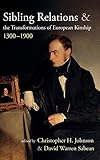Sibling Relations and the Transformations of European Kinship, 1300-1900 / ed. by David Warren Sabean, Christopher H. Johnson.
Material type: TextPublisher: New York ; Oxford : Berghahn Books, [2011]Copyright date: ©2011Description: 1 online resource (368 p.)Content type:
TextPublisher: New York ; Oxford : Berghahn Books, [2011]Copyright date: ©2011Description: 1 online resource (368 p.)Content type: - 9781845457693
- 9780857450463
- 306.875094 23
- online - DeGruyter
| Item type | Current library | Call number | URL | Status | Notes | Barcode | |
|---|---|---|---|---|---|---|---|
 eBook
eBook
|
Biblioteca "Angelicum" Pont. Univ. S.Tommaso d'Aquino Nuvola online | online - DeGruyter (Browse shelf(Opens below)) | Online access | Not for loan (Accesso limitato) | Accesso per gli utenti autorizzati / Access for authorized users | (dgr)9780857450463 |
Frontmatter -- Contents -- Figures and Illustrations -- Preface -- Introduction. From Siblingship to Siblinghood: Kinship and the Shaping of European Society (1300–1900) -- PART ONE. PROPERTY, POLITICS, AND SIBLING STRATEGIES (LATE MEDIEVAL AND EARLY MODERN) -- Chapter 1 Dowry: Sharing Inheritance or Exclusion? Timing, Destination, and Contents of Transmission in Late Medieval and Early Modern France -- Chapter 2 Maintenance Regulations and Sibling Relations in the High Nobility of Late Medieval Germany -- Chapter 3 Do Sisters Have Brothers? The Search for the “rechte Schwester” Brothers and Sisters in Aristocratic Society at the Turn of the Sixteenth Century -- Chapter 4 Subordinates, Patrons, and Most Beloved: Sibling Relationships in Seventeenth-Century German Court Society -- Chapter 5 The Crown Prince’s Brothers and Sisters: Succession and Inheritance Problems and Solutions among the Hohenzollerns, from the Great Elector to Frederick the Great -- Chapter 6 Evolution within Sibling Groups from One Kinship System to Another (Sixteenth to Nineteenth Centuries) -- PART TWO. SIBLING RELATIONS, CLOSE MARRIAGE, AND HORIZONTAL KINSHIP, 1750–1900 -- Chapter 7 Brother Trouble: Murder and Incest in Scottish Ballads -- Chapter 8 Siblinghood and the Emotional Dimensions of the New Kinship System, 1800–1850: A French Example -- Chapter 9 Kinship and Issues of the Self in Europe around 1800 -- Chapter 10 Sisters, Wives, and the Sublimation of Desire in a Jewish-Protestant Friendship: The Letters of the Historian Johann Gustav Droysen and the Composer Felix Mendelssohn-Bartholdy -- Chapter 11 Husband, Wife, and Sister: Making and Remaking the Early Victorian Family -- Chapter 12 Gender and Age in Nineteenth-Century Britain: The Case Of Anne, William, and Helen Gladstone -- Notes on Contributors -- Bibliography -- Index
restricted access online access with authorization star
http://purl.org/coar/access_right/c_16ec
Recently considerable interest has developed about the degree to which anthropological approaches to kinship can be used for the study of the long-term development of European history. From the late middle ages to the dawn of the twentieth century, kinship - rather than declining, as is often assumed - was twice reconfigured in dramatic ways and became increasingly significant as a force in historical change, with remarkable similarities across European society. Applying interdisciplinary approaches from social and cultural history and literature and focusing on sibling relationships, this volume takes up the challenge of examining the systemic and structural development of kinship over the long term by looking at the close inner-familial dynamics of ruling families (the Hohenzollerns), cultural leaders (the Mendelssohns), business and professional classes, and political figures (the Gladstones)in France, Italy, Germany, and England. It offers insight into the current issues in kinship studies and draws from a wide range of personal documents: letters, autobiographies, testaments, memoirs, as well as genealogies and works of art.
Mode of access: Internet via World Wide Web.
In English.
Description based on online resource; title from PDF title page (publisher's Web site, viewed 25. Jun 2024)


